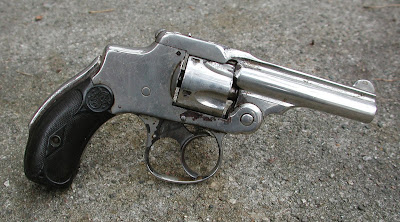
The real story behind the Safety Hammerless revolvers from Smith & Wesson is as hard to track down as many myths that predate the little revolvers by millennia. The popular lore is that Daniel B. Wesson was horrified by a newspaper account of a child who accidentally shot himself with daddy's revolver, and so he set out to design a safer handgun. An alternate explanation is that, with an increasingly urbanized population that was less likely to go openly "heeled", the American gun-buying public would respond to a small revolver with an enclosed hammer that wouldn't snag on clothing when drawn from coat pocket or purse, and which couldn't discharge if the hammer spur were struck on the pavement or bumped on the edge of the nightstand drawer.
Whatever the reason, the first S&W Safety Hammerless revolvers hit the market in 1887 in .38 S&W caliber. Officially termed the "New Departure", and known in popular slang as "lemon squeezers" for the grip safety on the backstrap, they were followed by a smaller .32 S&W caliber version the very next year.
The first .38 Safety Hammerless revolvers used a complex "Z-bar" latch that used lateral movement to unlock the downward-tipping barrel-and-cylinder assembly. This was replaced in the second year of production with a push-button mechanism that was shared by the first .32's as well. In an interesting note to our modern sensibilities, which are trained to flinch at the thought of lawyers, the "lemon squeezers" were originally shipped from the factory with a pin that could be used to disable the grip safety.
The push-button barrel latch was hardly a triumph of ergonomics. After all, as the shooter's support hand was trying to tip the barrel down for unloading, the tendency was to use the thumb of the strong hand to actuate the latch button, inadvertently applying enough pressure to hold the pistol shut. It was replaced in 1902 with a simple "t-bar" toggle that was intuitively operated by the support hand.
The Safety Hammerless top-breaks were wildly successful for Smith, continuing in production long after the more modern Hand Ejectors had supplanted the more conventional top-break revolvers. The .32 Safety Hammerless remained in production until 1937, and the .38 version wasn't discontinued until the eve of World War Two, in 1940. Even so, the concept of a small, pocket revolver with an enclosed hammer to avoid snagging on clothing is one that has yet to go out of style.
 It is interesting to note the similarities between the .32 Safety Hammerless 1st Model of over a century ago and the Model 432 .32 Magnum Centennial Airweight I carry in a coat pocket today. (The latter is the one with CTC Lasergrips...)
It is interesting to note the similarities between the .32 Safety Hammerless 1st Model of over a century ago and the Model 432 .32 Magnum Centennial Airweight I carry in a coat pocket today. (The latter is the one with CTC Lasergrips...)One of the most striking things about the old .32 top-breaks to our modern eyes is their almost lilliputian size. The cylinder of the .32 is about exactly half the length of the cylinder on a J-frame magnum, and the whole gun, 3" barrel and all, will lay in the palm of my hand without the barrel overhanging my fingertips, and I'm a long way from palming basketballs or playing concert piano.
The .32 Safety Hammerless 1st Model in the photos is in probably the most common configuration: Nickeled, and with a 3" barrel, the gun shows signs of hard use and a rough re-nickeling. I picked it up for a song, just barely over $100 at a gun show in late 2010, and the serial number dates it to the very early 1890s. It still times decently and locks up well, even though the bore is about as ugly as you'd expect for a well-used piece of its vintage. A nice one could bring four or five times that, easily, or more if it were in an unusual configuration.








